21 tips from the pros on getting the most from your action cam
Advice from extreme sports stars on filming killer footage
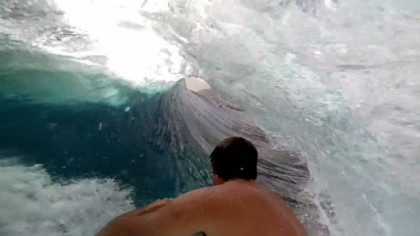
Experiment, experiment, experiment
Need advice on using your new action cam? Or simply trying to add some extra polish to your shots? Either way, you've come to the right place. Techradar has spoken to extreme sports pros – including athletes who have competed at World Championships and Winter Olympics – to get the low-down on filming killer footage.
Whether you're looking for some general pointers or sport-specific tips, we've got you covered.
If you've got any tips you think we've missed, share them in the comments below.
Doug Peel-Yates is three time British inline skating champion (and current UK number two). He also manages Team Extreme, an extreme sports show company featuring skateboarders, BMXers and inline skaters.
Try out new angles
Often the best shots are those filmed from unusual angles, Peel-Yates says, so let your imagination run wild. During one filming session, the team simply left their GoPro (they use the Hero 3 and Hero 4) on the floor and skated around it – giving viewers something they wouldn't see with their own eyes.
In another session, "we stuck the camera to the ramp and pointed it upwards, and the guys would do the tricks over the top of the camera. It's almost as if people were going away from you and then back past", Peel-Yates explains.
Keep it short and sharp
The best-performing Team Extreme videos – the ones that get shared and liked hundreds of thousands of times on social media – are the shortest: seven-second clips that showcase a couple of tricks. "If you've got enough going on people may have to watch it three, four times just to see everything," Peel-Yates adds.
There's still a place for longer, heavily edited videos – but try to keep them under three minutes long to make sure they grab viewers' attention, he says.
Try the Antix self-editing app
Peel-Yates says he doesn't always have time to sit down and spend hours editing reels of footage, and uses the Antix app to help. When it's running, it monitors your movement and makes a smart guess at when you've done something impressive. It then combines those moments into one longer clip to just review and share when you're ready.
"For the quick social media stuff, it's excellent," Peel-Yates says - plus it's free on both Android and iOS.
Learn from others
Whilst it's good to experiment, skaters should also learn from others. Peel-Yates built his own "helimount" – a helmet camera mount that spins around as you ride – after seeing something similar online, and it's the camera he uses to get the best angles. There's lots of creativity on the internet already, Peel-Yates says, so don't be afraid to tap into it.
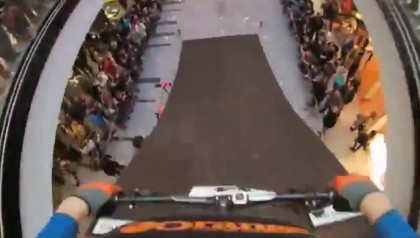
How to test your angles
Ben Moore is a professional mountain biker who competes around the world. He's currently touring Europe competing in Downmall, where top riders race through packed shopping centres for the best times. You can see more of his videos on Facebook, Instagram, or Twitter.
Link your smartphone to line up the best shots
Most action cams these days have Wi-Fi – including the Kaiser Baas, Moore's camera of choice. Through the company's app, he can see what the camera is filming just by glancing at his phone screen – it's ideal for testing shots, and adjusting the camera mounts on his helmet, chest, and bike to get the perfect view.
Film your helmet
When filming from a head mount it's a good idea to get some of your helmet in – just to give viewers a "point of reference", Moore says. "I've found it stabilises [the footage]. Rather than a blur going down a mountain, you've actually got something to look at," he adds.
Chest cameras: tilt them further than you'd think
Chest-mounted cameras are shaky, but they showcase all the work that goes through the riders hands – turning the handlebars, feathering the brakes, changing gears – better than any other camera.
But setting them up can be troublesome, and it's easy to get your angles wrong. The trick is to point the camera almost vertically up, and let the natural riding angles to the rest, he says. "You're leaning much further forward than you'd expect, plus you're going downhill."
Document your runs properly
Use your action cam regularly and you'll soon have a mountain of clips on your computer. To help you sift through, it's often helpful to tell your future self a quick summary of what's about to happen.
"I'll talk to the camera a little bit like a dictaphone, telling it: I'm at the top of such and such run," he explains. That means when Moore opens up any of the 1000s of videos in his library he knows exactly where the footage took place. "You can just crop that out and you're into a video".
Aim for 60 frames per second as a minimum
Moore has tried shooting in a variety of qualities – 4K, 2.4K, 720p – but has found that 1080p, 60 frames per second (FPS) is the optimal setting. 4K can be too much for some computers to handle, and while some cameras can give you more FPS, 60 is enough, he says.
But going lower isn't going to cut it. "There's a lot happening in a second because it's a fast moving sport. Regardless of what camera you're using, the framerate and quality is very important.
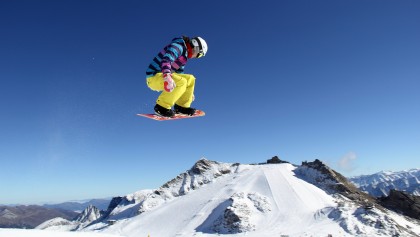
Framing shots: Advice from a winter Olympian
Zoe Gillings-Brier has competed at three Winter Olympics in snowboard cross (SBX) – a sport that involves racing very fast downhill racing around tight turns and over difficult jumps. With seven SBX World Cup podiums under her belt, she's the most successful British athlete at the discipline of all time.
Show off the slope
Action cams are all about filming yourself doing awesome stuff, but sometimes it's good to get some context. As a snowboarder, you've got the advantage of having soaring mountains surrounding you – and it's nice to remind viewers of that.
"At the bottom of the course, I'll stop and do a bit of a slow turn around to get a picture of where I am before I switch [the camera] off," she says. "[With the handheld camera] I'll do a bit of a pan shot of what's around me, especially if there's some really nice views."
YouTube : https://www.youtube.com/embed/9WNboRriYxI
How to frame selfie shots
Gillings-Brier says downhill shots are impressive (Zeal Optics goggles are her weapon of choice for recording that), but the best angles are looking backwards at the rider – it gives viewers a true sense of the speed you're travelling.
She uses a handheld DJI Osmo to do the job: it shoots video in 4K, and has a 3-axis stabilising gimbal to keep footage smooth.
Having the camera around chin height is the sweet spot: instead of having a backdrop of pure white snow – which would be dull – it means you'll get some of the horizon in. Angle the camera so you're on the edge of the shot, taking up about a third of the footage, and have the mountains fill the rest, she says.
Vary camera height
Chin-height works best for filming with a handheld, but don't be afraid to deviate away from that for the sake of variety. Having a camera slightly higher, looking down towards the board, gives an interesting perspective, as does having the camera low down, nearly sitting on the board next to your boots, Gillings-Brier says.
However, the latter is quite an awkward position to film in – so make sure you're going slow.
The best way to film jumps
If you're a snowboarder, chances are you enjoy going fast over big jumps – and you're going to want to get that on camera (if only for the epic crash landings).
To get the best view you'll need to grab a friend, Gillings-Brier says. Get them to stand next to the jump, level with it on the slope, and step back a couple of metres. "[That way] you can get the take off and get the landing and get the air as well," she says.
You can watch more videos of Zoe in action, and pick up more filming tips, on her website.

Footage so good you could kiss it
Nick Rees is a passionate surfer, and as operations manager of Surfing GB – the organising body for British surfing – he's picked up more than few tips on using action cams through the years.
Lick the camera
Yeah, you read that right. Many surfers have had their perfect shot ruined by droplets on the water housing that they use (and you should, too) to keep their cameras dry.
So what's the best way to stop that from happening? "It sounds stupid but licking the front of the water housing will disperse that," Rees says. Best to do that between runs rather than when you're in the middle of a wave, though...
Sand and wipe down your board
To make sure your camera is properly secured to your board, you'll want to first make sure it's as smooth as can be. "If you have any existing wax residue or salt, that limits the sticking power, so get some white spirit and wipe it down first," Rees advises.
Lightly sanding the area of your board that you plan to stick the camera to can be useful as well, and adding some extra superglue to a regular mount can't hurt either.
Put the camera in your mouth
Surf boards present a variety of angles for impressive shots on their own: looking forward from the front of the board to get a great view of the barrel of a wave; on the tail pad at the back of the board looking forward; or at the front of the board facing the rider.
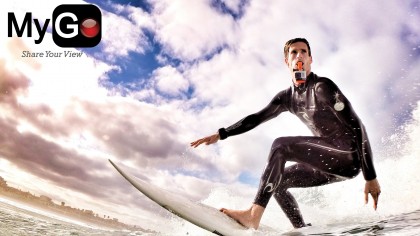
But if you want something a little different, you might try a mouth mount for your GoPro (yes, really), such as gum shield MyGo. "You can paddle, pop up on the wave, and then hold it in your mouth or take it off so it's in your hand. That's where you can get a view of [what's] behind you," Rees says.
Action cams as a training tool
You don't always have to use action cameras for great footage – they can also be used as a training tool, especially when correcting mistakes in popping up (that's surfer talk for going from the paddling position, lying on the board, to standing up straight).
"Focus on surfing rather than getting the shot, [and] you can see when you're going wrong," Rees says.
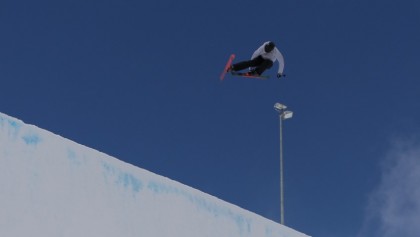
Using a pole in your action cam videos
Pete Speight is a professional freeskier, and member of the British half-pipe skiing team. At just 21 years of age, he's already competed in World Championships. He recently finished in the top 20 at the half-pipeskiing World Cup Finals in the French Alpes.
Make sure your helmet is snug
A helmet-mounted GoPro Hero4 Sessions can be a great tool for showing viewers what you're seeing when you head down the slope, Speight says. But to stop the camera shaking, strap your helmet a little tighter than you normally do and "make sure you've got a helmet that fits and it isn't wobbling around".
Vary the angles
As a freeskier, Speight spends a lot of his time tricking his way down half-pipes, which he admits looks a lot more "basic" than ski parks, with their jumps and rails. The same can be said of normal slopes, too – on their own, they're not that interesting.
The key to making an exciting action cam video, he says, is getting a friend to film you from a variety of angles. "In a point of view shot [from a head-mounted camera] you can't actually see yourself doing the trick, so you definitely need a mate filming you if you want to display your best skiing," Speight says.
Examples of angles that can work is having someone standing on the deck of the half-pipe, looking down; standing on the floor of the half-pipe, looking up; or standing downslope, so that they're jumping toward you. You can try this on the slopes, too: have a friend ski ahead and film you coming at them.
Work the pole
Speight uses a pole-mounted camera to get the best shots of team mates and friends. Because of the wide-angle lenses that action cams have, the closer you can get to the person you're filming, the better. You should essentially see the pole camera as a "follow cam", says Speight.
"Closeness is definitely good, it's a way more dramatic shot, and it's more detailed."
Only try this if you're a competent skier, though – getting the best shots will require some skill. "You've got to follow the person over or next to the features they're hitting. Going off a jump at the same time as someone next to them, that's a good angle".
Don't splash the cash needlessly
Speight bought his own pole mount for his GoPro from Walmart in the US on the cheap. And you don't need to spend a bundle on expensive tech, he says. "As long as it's a pole that's secure, you're fine really".
Watch more videos of Pete on his website or Facebook page.